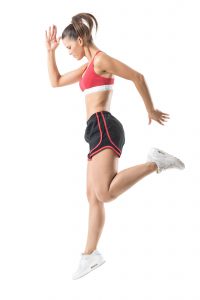How to protect your knees while playing summer sports
With the summer season upon us, there’s no better time to get outside and get active. Although we all fancy ourselves as a Federer on the court or a Farah on the track, unlike the pros, a good chunk of us are unaware of the injury risks that come with sport. Doing your best to prevent injury is important, so here’s our guide on how to protect your knees while playing sports this summer.
 The warm-up
The warm-up
Before engaging in any exercise, nothing is more important than warming-up and your knees are no exception. Whether you’re playing sport in the sunshine competitively or recreationally, it’s essential to flex and stretch the knee prior to any activity. By stretching and flexing the knee, blood moves around the joint and the muscles, tendons, and ligaments that surround it. This prepares your knee for the movements required during sport and is the best way to prevent injury.
When deciding what to do for your warm-up, consider that your knees work best when your joints are properly lubricated. Your joints are self-lubricating and do this by releasing a substance called synovial fluid. Synovial fluid is most effective when a joint experiences a range of motion, so expect to do a lot of knee bending in your warm-up.

Preparing the muscles
During most summer sports your knees will be the recipient of weight-bearing exercise. This is where your muscles and bones work against gravity through your feet on the ground. So sports such as running, tennis or football are examples of this type of exercise. In order to prepare for these activities it is essential that your hamstrings and quadriceps are stretched to avoid injury. The quadriceps are engaged whenever you extend your knee and the hamstrings allow for your knees to flex and rotate.
Dynamic over static stretching
In order to prevent injury to your knees, dynamic stretching should be a focal point of your warm-up. While static stretching – which involves elongating a muscle and holding it for a period of time – is beneficial after exercise, dynamic stretching of the knee is most appropriate prior to summer sports. This type of stretching involves slow, active movements of the legs, such as lunges, heel flicks, or leg lifts.
Try it out
There’s a variety of ways to warm up your knees, but here’s our quick routine to get yourself properly prepared for some summer sport.
Running
First, start by gradually increasing the movement in your legs: begin by walking, then progress into a light jog and continue to build up speed in a slow and controlled manner. You don’t have to go too fast and either slow down or stop entirely should you feel any pain. After about five minutes, try out some dynamic stretches. With all of your dynamic stretches, keep the motions small, increasing the range of the motion with each repetition. Spend two to five minutes on your stretches in total, but don’t worry too much about how long your stretching lasts for, as long as your knees and the muscles around them feel loose and ready to go.
Dynamic stretches
Small lunges are always a good transition exercise from running into stretching. To practice small lunges, place both of your hands on your head, keep your core tight and begin to take small steps forward. As you take each step, drop your trailing knee to within a few centimetres of the floor. Your front leg should be at 90-degrees and your upper body held upright. Repeat this until you have completed between five and 10 steps with each leg (do what you feel comfortable with and don’t over-work yourself).
Next, try some heel flicks. Take short steps forward and lift your heels up as close to your bottom as you can. Try to build up a rhythm with this motion and bounce gently from one leg to the other as you kick your heels up. Aim to complete as many heel flicks as you can over 10 to 30 metres and repeat two to three times.
The final part of our warm-up routine is high knees. Move forward at a slow jogging pace and lift your knees up one at a time to about waist height as you move. Try to be light on your feet and don’t lean back as you lift your knees. If you struggle to get to waist height, don’t worry, just elevate your knees to a comfortable height and repeat. Look to complete this exercise in a similar way to heel flicks and target as many high knee motions as you can over 10 to 30 metres and repeat two to three times.



Resting, healing, growing
Once you’ve finished playing sport, it is essential to treat your knees with care to ensure they’ll be good to go for next time.
Active rest
Summer sports can be tough on your joints. They often require a sudden change of movement and face consistent impact from the ground as well as other people or equipment. One way to keep your knees healthy after sport is through non-weight-bearing activity. Swimming laps, riding a bicycle or rowing a rowing machine, are all examples of ways to gently let your joints recover after sport. If you don’t have access to a swimming pool, bicycle or rowing machine, passive yoga poses can be a great way to help out your knees. Many yoga poses affect the muscles around your knees that keep them strong. This helps them to recover and increases their strength for the future. If you want to try some yoga poses, you can watch a tutorial by clicking here
A touch of cold
Where warming-up your joints before sport is essential, cooling them down afterwards is also important. Applying an ice pack to your knees, or the muscles surrounding them, is one of the most effective ways to calm inflammation and alleviate pain. Hold or rest an ice pack against your knee for at least 20 minutes. If your skin is sensitive or responds negatively to the ice, place a thin cloth or towel between your knee and the ice to reduce the discomfort.
You can book a consultation with Mr Marcus Green, who is regarded as one of the West Midlands’ finest knee surgeons.
Medstars Medical Concierge Service
Looking for extra guidance when it comes to your healthcare? Sometimes interpreting medical information and making the best decisions can be daunting and complicated. Our private medical concierge service provides easy access to top UK health experts. We guide our patients with genuine choice and trust, offering a bespoke service for anyone in the world seeking private UK healthcare. Learn more about Medstars Medical Concierge Service. Want to learn more about providing our medical concierge service as an employee benefit? Learn more about Medstars Medical Concierge for Business.

